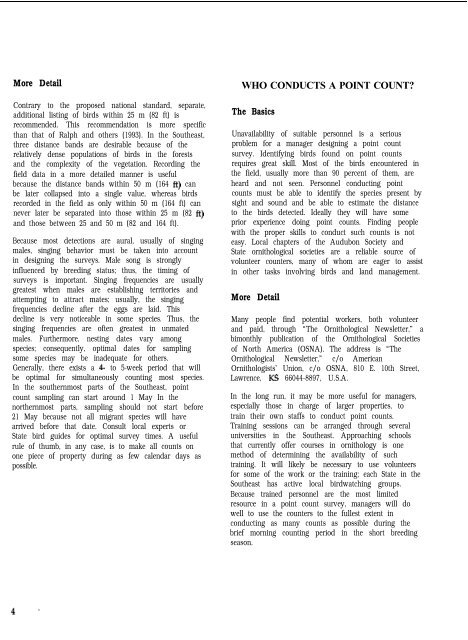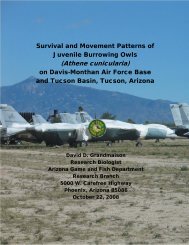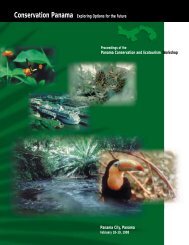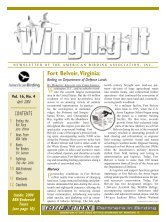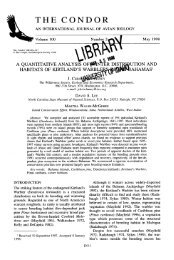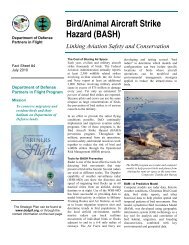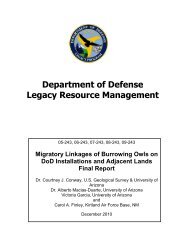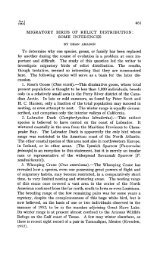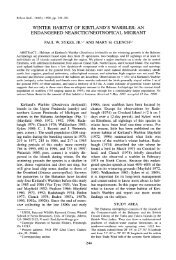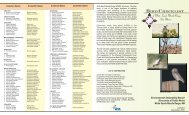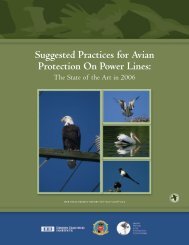A Land Manager's Guide to Point Counts of Birds in the Southeast
A Land Manager's Guide to Point Counts of Birds in the Southeast
A Land Manager's Guide to Point Counts of Birds in the Southeast
You also want an ePaper? Increase the reach of your titles
YUMPU automatically turns print PDFs into web optimized ePapers that Google loves.
More Detail WHO CONDUCTS A POINT COUNT?<br />
Contrary <strong>to</strong> <strong>the</strong> proposed national standard, separate,<br />
additional list<strong>in</strong>g <strong>of</strong> birds with<strong>in</strong> 25 m (82 ft) is<br />
recommended. This recommendation is more specific<br />
than that <strong>of</strong> Ralph and o<strong>the</strong>rs (1993). In <strong>the</strong> Sou<strong>the</strong>ast,<br />
three distance bands are desirable because <strong>of</strong> <strong>the</strong><br />
relatively dense populations <strong>of</strong> birds <strong>in</strong> <strong>the</strong> forests<br />
and <strong>the</strong> complexity <strong>of</strong> <strong>the</strong> vegetation. Record<strong>in</strong>g <strong>the</strong><br />
field data <strong>in</strong> a more detailed manner is useful<br />
because <strong>the</strong> distance bands with<strong>in</strong> 50 m (164 ft) can<br />
be later collapsed <strong>in</strong><strong>to</strong> a s<strong>in</strong>gle value, whereas birds<br />
recorded <strong>in</strong> <strong>the</strong> field as only with<strong>in</strong> 50 m (164 ft) can<br />
never later be separated <strong>in</strong><strong>to</strong> those with<strong>in</strong> 25 m (82 ft)<br />
and those between 25 and 50 m (82 and 164 ft).<br />
Because most detections are aural, usually <strong>of</strong> s<strong>in</strong>g<strong>in</strong>g<br />
males, s<strong>in</strong>g<strong>in</strong>g behavior must be taken <strong>in</strong><strong>to</strong> account<br />
<strong>in</strong> design<strong>in</strong>g <strong>the</strong> surveys. Male song is strongly<br />
<strong>in</strong>fluenced by breed<strong>in</strong>g status; thus, <strong>the</strong> tim<strong>in</strong>g <strong>of</strong><br />
surveys is important. S<strong>in</strong>g<strong>in</strong>g frequencies are usually<br />
greatest when males are establish<strong>in</strong>g terri<strong>to</strong>ries and<br />
attempt<strong>in</strong>g <strong>to</strong> attract mates; usually, <strong>the</strong> s<strong>in</strong>g<strong>in</strong>g<br />
frequencies decl<strong>in</strong>e after <strong>the</strong> eggs are laid. This<br />
decl<strong>in</strong>e is very noticeable <strong>in</strong> some species. Thus, <strong>the</strong><br />
s<strong>in</strong>g<strong>in</strong>g frequencies are <strong>of</strong>ten greatest <strong>in</strong> unmated<br />
males. Fur<strong>the</strong>rmore, nest<strong>in</strong>g dates vary among<br />
species; consequently, optimal dates for sampl<strong>in</strong>g<br />
some species may be <strong>in</strong>adequate for o<strong>the</strong>rs.<br />
Generally, <strong>the</strong>re exists a 4- <strong>to</strong> 5-week period that will<br />
be optimal for simultaneously count<strong>in</strong>g most species.<br />
In <strong>the</strong> sou<strong>the</strong>rnmost parts <strong>of</strong> <strong>the</strong> Sou<strong>the</strong>ast, po<strong>in</strong>t<br />
count sampl<strong>in</strong>g can start around 1 May In <strong>the</strong><br />
nor<strong>the</strong>rnmost parts, sampl<strong>in</strong>g should not start before<br />
21 May because not all migrant species will have<br />
arrived before that date. Consult local experts or<br />
State bird guides for optimal survey times. A useful<br />
rule <strong>of</strong> thumb, <strong>in</strong> any case, is <strong>to</strong> make all counts on<br />
one piece <strong>of</strong> property dur<strong>in</strong>g as few calendar days as<br />
possible.<br />
The Basics<br />
Unavailability <strong>of</strong> suitable personnel is a serious<br />
problem for a manager design<strong>in</strong>g a po<strong>in</strong>t count<br />
survey. Identify<strong>in</strong>g birds found on po<strong>in</strong>t counts<br />
requires great skill. Most <strong>of</strong> <strong>the</strong> birds encountered <strong>in</strong><br />
<strong>the</strong> field, usually more than 90 percent <strong>of</strong> <strong>the</strong>m, are<br />
heard and not seen. Personnel conduct<strong>in</strong>g po<strong>in</strong>t<br />
counts must be able <strong>to</strong> identify <strong>the</strong> species present by<br />
sight and sound and be able <strong>to</strong> estimate <strong>the</strong> distance<br />
<strong>to</strong> <strong>the</strong> birds detected. Ideally <strong>the</strong>y will have some<br />
prior experience do<strong>in</strong>g po<strong>in</strong>t counts. F<strong>in</strong>d<strong>in</strong>g people<br />
with <strong>the</strong> proper skills <strong>to</strong> conduct such counts is not<br />
easy. Local chapters <strong>of</strong> <strong>the</strong> Audubon Society and<br />
State ornithological societies are a reliable source <strong>of</strong><br />
volunteer counters, many <strong>of</strong> whom are eager <strong>to</strong> assist<br />
<strong>in</strong> o<strong>the</strong>r tasks <strong>in</strong>volv<strong>in</strong>g birds and land management.<br />
More Detail<br />
Many people f<strong>in</strong>d potential workers, both volunteer<br />
and paid, through “The Ornithological Newsletter,” a<br />
bimonthly publication <strong>of</strong> <strong>the</strong> Ornithological Societies<br />
<strong>of</strong> North America (OSNA). The address is “The<br />
Ornithological Newsletter,” c/o American<br />
Ornithologists’ Union, c/o OSNA, 810 E. 10th Street,<br />
Lawrence, KS 66044-8897, U.S.A.<br />
In <strong>the</strong> long run, it may be more useful for managers,<br />
especially those <strong>in</strong> charge <strong>of</strong> larger properties, <strong>to</strong><br />
tra<strong>in</strong> <strong>the</strong>ir own staffs <strong>to</strong> conduct po<strong>in</strong>t counts.<br />
Tra<strong>in</strong><strong>in</strong>g sessions can be arranged through several<br />
universities <strong>in</strong> <strong>the</strong> Sou<strong>the</strong>ast. Approach<strong>in</strong>g schools<br />
that currently <strong>of</strong>fer courses <strong>in</strong> ornithology is one<br />
method <strong>of</strong> determ<strong>in</strong><strong>in</strong>g <strong>the</strong> availability <strong>of</strong> such<br />
tra<strong>in</strong><strong>in</strong>g. It will likely be necessary <strong>to</strong> use volunteers<br />
for some <strong>of</strong> <strong>the</strong> work or <strong>the</strong> tra<strong>in</strong><strong>in</strong>g; each State <strong>in</strong> <strong>the</strong><br />
Sou<strong>the</strong>ast has active local birdwatch<strong>in</strong>g groups.<br />
Because tra<strong>in</strong>ed personnel are <strong>the</strong> most limited<br />
resource <strong>in</strong> a po<strong>in</strong>t count survey, managers will do<br />
well <strong>to</strong> use <strong>the</strong> counters <strong>to</strong> <strong>the</strong> fullest extent <strong>in</strong><br />
conduct<strong>in</strong>g as many counts as possible dur<strong>in</strong>g <strong>the</strong><br />
brief morn<strong>in</strong>g count<strong>in</strong>g period <strong>in</strong> <strong>the</strong> short breed<strong>in</strong>g<br />
season.


